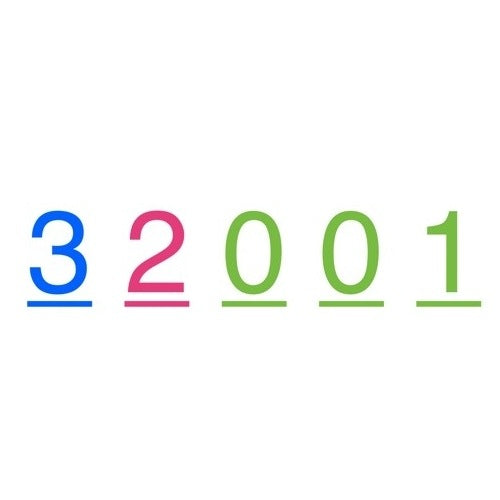
The Leon Decimal System
I thought this title may grab you a little more than “How to Assign Style Numbers!”
I’ve noticed over the past several years that designers are using the term “numbers” lightly when assigning style numbers to their samples. Instead of assigning a number like 7657743 to a red silk dress, they might name the dress “Scarlet.” And this does make sense, as the fashion industry is mostly driven by emotions. It would be more effective to call a product by a name that’s brand appropriate, rather than one that sounds like you are at a hardware store. However, in my experience, this seemingly small detail could be very costly to your overhead and operations. It’s something most small designers wouldn’t normally think about (I mean it’s just a style number right!) especially before the number of styles they’ve produced starts to get up there. Well, in this post I would like to discuss the pros and cons of both assigning a name to a garment and assigning an actual number (or alpha numerical code).
Disadvantages to Assigning a Name:
First let’s start with the disadvantages. The biggest drawback I see to assigning names is that it can turn into a logistical nightmare. Cataloging, locating and managing your styles and patterns can become very complex, especially as you grow your business and the style numbers start to really pile up. Most start-up fashion labels don’t see past their first season, and are focused on just being noticed rather than on how much money is going to be wasted simply finding things ten seasons down the road. (Those are all part of the fun conversations you will be having with your accountant one day.) Let’s say you have a style called “Sandrine.” Where or how would you file something like that? Most people think, “oh that’s easy…it’s spring 2011,” and pull out a yellow envelope. However, after 1000 styles you won’t remember where it is…. or maybe you will but your staff sure won’t. And you’ll be spending your valuable time answering questions like “where is this style?” or “what season is this?” or “where do I find that?” As a business owner, I can tell you that it will be a colossal waste of your time. You will either be answering these types of questions all day long or have a huge staff that is answering questions instead of designing or expanding your business.
You could file your styles alphabetically, but then you would have to mix old and new seasons together. For example, if two seasons after Sandrine you created an “Abigail,” where would you file that? If you did keep them filed alphabetically by season then you’d have to create a master list or spreadsheet listing all seasons and style names. However, if you are in the fashion industry or any industry that presents collections and samples at trade shows then you know that in the 11th hour, everyone is scrambling around just to complete products. During that time many steps get bypassed or forgotten, which can result in huge filing and inventory problems down the road.
Advantages to Assigning a Name:
The biggest benefit to assigning styles a name rather than a number is that names elicit an emotional response. A sexy red dress called “Roxanne” would not create the same effect as if it were called “Mother Teresa.” Fashion is about an image a person wants to project to the world. By naming your style you further communicate your design to your consumer or your buyer, if you are selling to stores.
Another benefit, quite simply, is that it is easy to remember. If you made a hundred Roxannes and told your factory to cut another Roxanne they would most probably know exactly what you’re talking about. Names are easier to remember since our brains are wired to think with images.
Style Numbers or Alpha Numeric Codes
Disadvantage of Using Numbers in Style Numbers
The most obvious disadvantage would be that numbers are more difficult to remember. Also, referring to a sexy red silk dress as 127364532 might make you feel a little like you are in the auto industry instead of a creative field like fashion or home goods.
Another disadvantage is that numbers can get easily mixed up without triggering the same reaction as calling someone by the wrong name. The following problems can also occur:
- When assigning style numbers – If this error is missed this can lead to costly disasters.
- Reading a wrong style number – Again this can be a costly error and can be caused by your internal staff, your subcontractors or by your buyers. When the source of costly errors are from external sources like the buyer of the biggest department store…the situation can be uncomfortable to say the least.
- Duplicates from rollover – This problem is similar to that of an automobile odometer. If your style count exceeds the capacity of your numbering system and you are forced to rollover and start cycling through the same numbers, you will create duplicate style numbers. The way to handle the rate of cycling through is to add more digits to your style number. However, the longer the string the more likely it is to be misread.
For example, it’s easier to read style #867 than it is to read style #8675309.
Advantages of Using Numbers in Style Numbers
In my opinion the two biggest advantages for using numbers or a combination of numbers and letters are:
- You can create a codified system within the style number to help identify what the product is.
- The fact that you are working with numbers lends itself easily to documenting as well as a retrieval system.
The system that I always used was a system created by my father Leon, hence the joke I made in the title of this blog post. His style numbering system was as follows:
- All style numbers were five digits. Not too long and not too short! When you saw a digit string of numbers you immediately knew it was a style number.
- The first digit in the string of numbers always reflected the year the style number was issued.
- The second digit was a code that identified the type of garment. This way if you had no idea what the style number was, you could look at the second digit and know whether you were looking for a gown or a skirt. Trust me – that can be very handy when you are sifting through inventory lists.
- The last three digits were numbers assigned in sequential order.
The info-graphic below illustrates the codification of our style numbering system:

The category codes we used in the second digit in our style numbers where as follows:
0= Suit or 2pc Set
1 = Jacket
2 = Skirt
3 = Blouse
4 = Culotte
5 = Pants
6 = Camisole
7 = Gown
8 = Accessory
9 = Short Dress
Another advantage to this system was that the first two fields were coded. That reduced the possibility of errors caused by some of the dyslexics in the world! For example, if the second digit was incorrect you could use that information to question orders that did not make sense. If someone ordered two jackets and six pairs of pants you might be prompted to ask about verifying the order. Or if some of the latter numbers where switched, the error would still be detectable if you noticed one of the first two numbers was wrong (a much easier task than remembering endless five digit numbers!).
The way to file your styles was by the continuous number of the last three digits. We would print out a tech sheet with all the pertinent data for the style such as pattern number, buttons, trim, etc. We would then make a sketch of the style, assign the number and file it in a three ring binder. Instead of printing a hard copy you could just keep it digitally, but for me that did not make sense. The styles where always referenced and it was easier for people to grab a binder from a shelf than log on to the computer. This would especially hold true for some of the people we had working in production who were not tech savvy. If you do decide to keep it digitally, I would recommend rearranging your numbers so the three digit continuous numbers are in the front of the style number and the code at the end since a computer arranges file names in numerical order. Let me show you what I mean. Assuming we are assigning styles this year and we are in the 100 series of continuous numbers.
39100 – Short Dress
37101 – Long Dress
36102 – Camisole
35103 – Pants
31104 – Jacket
If I was filing this manually I would disregard the first two digits and file in order of the last three digits. If these numbers were stored as file names in a computer they would be in the following order:
31104
35103
36102
37101
39100
As you can see, the files would be filed by the total numerical value. You can still find the style that you are looking for, but if you wanted to see your styles listed in the order they were assigned it would be difficult. Again, this post is just to expand our viewpoint regarding the logistics of one small aspect of running your business. Some of these points may be important to you and some not. It’s up to you to decide what works for your business. You may think you are the only one who needs to look up this information, and if you need to show it to someone else, you can just print it out.
In Conclusion
I’m not suggesting that this is the only way to manage your styles…there are many ways to skin a cat. This is just to get your wheels spinning and think about how to run your business. Every business is unique so it must be tailored to your requirements . If your business only has 10 to 50 products then a naming system would be fine for you. If you create hundreds of styles then the management of your style numbers could become a problem, and when I say problem, ultimately I am referring to lost money or loss of customers.


